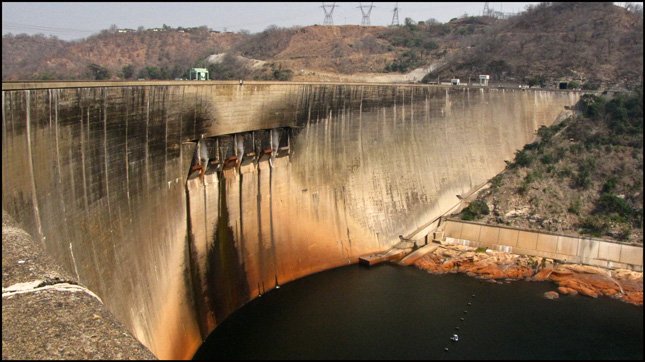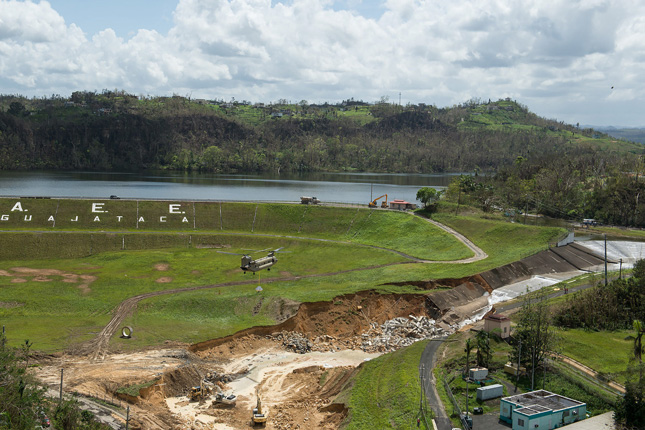-
Big Dams, Big Damage: The Growing Risk of Failure
August 21, 2018 By Olivia Smith
Last month, a partially completed dam in Laos’ Attapeu province collapsed, washing away people and villages in its path. Hundreds of people are still missing and more than six thousand are homeless. And after last summer’s hurricanes, U.S. citizens in Houston and Puerto Rico escaped death but were forced to evacuate when dams were flooded. Dam failure can be catastrophic for people, property, and power—and the risks are rising, due to lack of investment in maintenance, growing vulnerability to climate change, and the demonstrated potential of cyberattacks.
The Catastrophic Consequences of Dam Failure
The worst dam failure in history, in China’s Henan Province in 1975, killed tens of thousands of people. When the 400 foot-high Banqiao Dam burst, its 17.4 billion cubic feet of water destroyed 62 smaller dams and levees downstream. The injuries, water contamination, and food shortages that followed increased the total death toll to an estimated 200,000 people.
According to the International Commission on Large Dams, more than 59,000 dams have reservoirs big enough to flood entire communities. The decaying Kariba hydroelectric dam between Zimbabwe and Zambia holds the largest volume of water of any manmade lake. Its collapse could inundate millions and destroy a dam downstream in Mozambique.
In the United States, more than 2,000 of the 15,000 U.S. dams with high-hazard potential are considered deficient due to a lack of investment in maintenance—leading the American Society of Civil Engineers to give the country’s dam safety a grade of “D” on its Infrastructure Report Card.
In addition to life and property, the failure of a hydroelectric dam threatens energy security. Hydropower generates almost eight percent of U.S. electricity. The share can be much higher in some developing countries, such as Brazil, where dams generate more than three quarters of the country’s electricity. The Itaipu Dam, between Brazil and Paraguay, generates enough electricity each year to power the entire world for two days.
At-Risk Dams Not Prepared for Extreme Weather
Extreme weather—which is becoming more severe and frequent as the climate changes—is striking this critical infrastructure more often, with devastating results. After Hurricane Harvey, the U.S. Army Corps of Engineers released water from Houston’s Addicks and Barker dams—two of the most high-risk dams in the country—inundating several thousand buildings with controlled releases to avoid destroying most of the city. In Puerto Rico, Hurricane Maria cracked the Guajataca Dam, while downpours began to erode its spillway. The town of Isabela flooded and hundreds of people in the surrounding towns were forced to evacuate.
In February 2017, torrential rains filled California’s Oroville Dam—the tallest in the country—above capacity. After discovering that the original spillway had a sinkhole, officials diverted water to an emergency spillway, but the resulting erosion threatened the concrete structure above. With dam failure looming, nearly 200 thousand people were evacuated—and thousands of evacuees were stuck in traffic, unable to escape the danger zone. Luckily, the dam held; but if it had failed, water and power supplies for millions of California residents would have been disrupted.
Across the world, the risks of dam failure are increasing, because engineering plans and risk management strategies are not keeping pace with the deteriorating infrastructure or escalating extremes in weather and climate. According to Kathleen White of the U.S. Army Corps of Engineers, the designs of existing dams were modeled on hydro-climatic data now made obsolete by climate change.
As 100-year floods or rain events become more common, U.S. dam operators’ standard safety instrument, the Emergency Action Plan, should be updated to reflect the increasing likelihood of potential emergencies. But shockingly, the U.S. Association of State Dam Safety Officials found that more than one fifth of the dams whose failure could cause fatalities and property damage did not even have such a plan.

Dam Systems Vulnerable to Cyberattacks
Much of our critical infrastructure is computer-operated via industrial control systems. Should hackers penetrate these systems, they could destroy or shut down vital equipment in a matter of keystrokes. In December 2015, Russian hackers attacked two Ukrainian power companies, causing nearly a quarter-million people to lose power. Some speculate this attack was a practice run for future infrastructure attacks on the United States.
To date, no attack has shut down U.S. facilities, but hackers have successfully penetrated U.S. dams’ defenses. In 2013, Iranian hackers breached a small, computer-operated dam in Rye Brook, New York; some speculate that the intended target was actually the much larger Arthur A. Bowman dam. That same year, Chinese hackers penetrated the U.S. Army Corps’ National Inventory of Dams, which contains sensitive information on dams’ vulnerabilities. Attacks come from close to home as well: A recent report from the Department of the Interior’s Inspector General revealed that poor practices with employee access and account management left the U.S. Bureau of Reclamation’s dam facilities exposed to insider attack.
A 2015 report from Lloyd’s estimates that the economic costs of a hypothetical cyberattack on 50generation facilities in the northeastern United States would exceed $243 billion and could reach nearly $1 trillion. While power outages from a single large hydroelectric dam would not be as widespread, it could black out part of a large city, shutting off critical services like water treatment and hospitals. If the hack released water from the reservoir, the effects of unplanned flooding would be horrific.
Protecting Dams From Natural and Human Threats
Following the September 11 attacks, the United States launched the National Infrastructure Protection Plan, which includes interagency task forces and information-sharing mechanisms, such as Homeland Security’s Dams Portal. The plan’s counter-cyber operations complement FEMA’s National Dam Safety Program, which orchestrates regulation and best practices on dam design and risk management across several agencies. If they work together, these federal programs could help make U.S. dam infrastructure more resilient to both natural and human threats.
Another critical step in protecting critical infrastructure is decommissioning old dams. The average age of a U.S. hydroelectric dam is 64 years, and many are classified as being high risk. Decommissioning aging, high-risk dams could help avert disaster–and has the additional benefits of improving ecosystems by allowing rivers to run freely and support the return of aquatic species and plants.
Finally, we need to repair dams that can be fixed. As Puerto Rican communities struggle to recover from Hurricane Maria, the Guajataca Dam is patched and 114 displaced families are back in their homes. However, the dam has not been hardened against severe storms, and the U.S. Army Corps estimates that it will be working until July 2019 to stabilize the dam and spillway. It will take even longer before Guajataca is resilient to the ever-increasing extreme weather events that climate change has in store.
Sources: Al Jazeera, American Society of Civil Engineers’ Infrastructure Report Card, Association of Dam Safety Officials, BBC, Engineering News Record – ENR Southeast, Encyclopedia Britannica, Free Beacon, The Hill, Houston Press, International Commission on Large Dams, Lloyd’s Emerging Risks Report, New York Times, New Yorker, Nextgov, Scientific American, U.S. Department of Homeland Security, U.S. Energy Information Agency, U.S. Federal Emergency Management Agency, University of California-Davis Watershed Information,
Photo Credits:
1. The Kariba Dam, which generates hydro-electric power for Zambia and Zimbabwe, September 2010. Courtesy of Joe McKenna.
2. A CH-47 Chinook helicopter from the Pennsylvania Army National Guard emplaces a large sand bag in the spillway of the Guajataca Dam on Oct. 9, 2017. The Soldiers are working to stabilize the dam’s spillway in conjunction with the U.S. Army Corps of Engineers and the Puerto Rico Army National Guard in response to the effects of Hurricane Maria. (36th Infantry Division photo by SSG Mark Scovell)
 A Publication of the Stimson Center.
A Publication of the Stimson Center.




